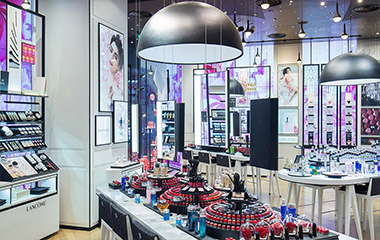Cosmetics market
The world of beauty
in 2016
To navigate from one section to another:
Scroll with your mouse
or
Use the arrows on your keyboard
Cosmetics market remains buoyant
Cosmetics market
remains buoyant
Growth of the worldwide cosmetics market over ten years(3)
Breakdown of the market by geographic Zone(1)
- 36.9% Asia, Pacific
- 24.8% North America
- 19.3% Western Europe
- 10.2% Latin America
- 6.0% Eastern Europe
- 2.9% Africa, Middle East
Breakdown of the market by product category(1)
36.3% Skincare
22.9% Haircare
18.2% Make-up
12.0% Fragrances
10.5% Hygiene products
Main worldwide players in sales
(in billions of USD)(4)
Acceleration
of online sales

Acceleration
of online sales
of online sales
Boom in make-up market
Boom in make-up market
For the fourth consecutive year, the make-up category drove cosmetics market growth worldwide. The reasons behind this swift expansion across all regions and beauty sectors are analysed in detail below.
Record growth(1) +8.4%
In all geographic Zones, the make-up market is growing faster than the cosmetics market(1)
- x2North
America - x2New
Markets - x6Western
Europe
Make-up is the most dynamic category in all sectors(7)
Luxury
Mass-market
Professional
Lipstick hits the headlines
Lipstick hits
the headlines




















1.5
billion
lip make-up products sold per year(8)
Powerful growth potential
Penetration rates still relatively modest in some geographical areas
- United States68%
- China28%
- France60%
- Brazil50%
% of women who use at least one lip make-up product per year(9)
A lipstick for each country
In the United States
American women are amongst the top lip product users, ranging from coloured lip balm to lip gloss and liquid lipstick(10).In China
Chinese women are amongst those with the strongest preference for natural colours, such as beige and pinkish beige, and appreciate discreet make-up(11).In France
Young women in France use more lip gloss and pale, transparent colours, compared to their elders(12).In Brazil
Brazilian women use lip products frequently. Young women prefer discreet products; their elders appreciate softness and moisture(13).
New generations reinvent make-up
New generations reinvent make-up
The make-up boom is driven by the selfie generation, and the fast-growing use of social media, which focuses on appearance, self-expression and presentation. The new generations are reinventing uses, giving trends their own spin, and creating buzz for new looks.
Who are the new make-up consumer generations?
Millennials
Born between 1980 and 2000
Generation Z
Born between 1995 and 2010
1980
1990
2000
2010
New generations have a significant beauty spending budget(14)
Beauty spending by generation
The new generations set and follow the trends
The L'Oréal business model
L’Oréal is ideally placed to seize the potential of the make-up market
Thanks to its unique palette of complementary brands across all beauty sectors, from luxury to mass-market, L’Oréal is well-equipped to identify and respond to all make-up desires everywhere in the world, and to seize the opportunities of this fast-growing category.
- The two top worldwide make-up brands
- The highest growth in the market
- Emblematic signatures with complementary positioning in the Luxury sector
- A specialist nail care
and varnish brand - A newcomer to the portfolio: a skincare make-up brand developed with plastic surgeons
(1) Source: L'Oréal 2016 estimates of the worldwide cosmetics market in net manufacturer prices. Excluding soaps, oral hygiene, razors and blades. Excluding currency effects.
(2) Source: WWD, "Beauty’s Top 100", April 2016.
(3) Source: L'Oréal estimates of the worldwide cosmetics market in net manufacturer prices. Excluding soaps, oral hygiene, razors and blades. Excluding currency effects.
(4) Source: WWD, "Beauty’s Top 100", April 2016. Based on 2015 sales.
(5) WWD estimates of cosmetics sales.
(6) WWD estimates of cosmetics sales. Before the disposal of 43 brands to Coty.
(7) Excluding dermocosmetics. Source: L'Oréal 2016 estimates of the worldwide cosmetics market in net manufacturer prices. Excluding soaps, oral hygiene, razors and blades. Excluding currency effects.
(8) Source: Euromonitor, 2015 data.
(9) Source: Women aged between 15 and 75 in the United States and Europe, between 15 and 80 in Japan, between 15 and 65 in Russia, Brazil and China, and between 15 and 55 in India, Beauty Track, 2012-2013.
(10) Source: Women aged between 15 and 65, Beauty Track, 2012-2013.
(11) Source: Women aged between 15 and 40, U&A qualitative study, 2014.
(12) Sources: Women aged between 15 and 65, Beauty Track, 2012-2013. Women between 15 and 75, U&A qualitative study, 2014.
(13) Source: BeautyTrack
(14) Source: Ipsos, 2015 qualitative study, "Only include the beauty products you buy with your own money and not products bought for you by other people".

























